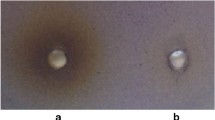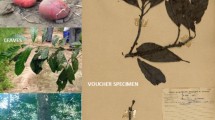Abstract
With an upsurge in multidrug resistant bacteria backed by biofilm defence armours, there is a desperate need of new antibiotics with a non-traditional mechanism of action. Targeting bacteria by misguiding them or halting their communication is a new approach that could offer a new way to combat the multidrug resistance problem. Quorum sensing is considered to be the achilles heel of bacteria that has a lot to offer. Since, both quorum sensing and biofilm formation have been related to drug resistance and pathogenicity, in this study we synthesised new derivatives of citral with antiquorum sensing and biofilm disrupting properties. We previously reported antimicrobial and antiquorum sensing activity of citral and herein we report the synthesis and evaluation of citral and its derivatives (CD1-CD3) for antibacterial, antibiofilm and antiquorum sensing potential against Chromobacterium violaceum using standard methods. Preliminary results revealed that CD1 is the most active of all the derivatives. Qualitative and quantitative evaluation of antiquorum sensing activity at sub-inhibitory concentrations of these compounds also revealed high activity for CD1 followed by CD2, CD3 and citral. These compounds also inhibit biofilm formation at subinhibitory concentrations without causing any bacterial growth inhibition. These results were replicated by RT-qPCR with down regulation of the quorum sensing genes when C. violaceum was treated with these test compounds. Overall, the results are quite encouraging, revealing that biofilm and quorum sensing are interrelated processes and also indicating the potential of these derivatives to impede bacterial communication and biofilm formation.




Similar content being viewed by others
Data availability
Not applicable.
References
Ahmad A, van Vuuren S, Viljoen A (2014) Unravelling the complex antimicrobial interactions of essential oils–the case of Thymus vulgaris (thyme). Molecules 19(3):2896–2910
Ahmad A, Viljoen AM, Chenia HY (2015a) The impact of plant volatiles on bacterial quorum sensing. Lett Appl Microbiol 60(1):8–19
Ahmad A, Wani MY, Khan A, Manzoor N, Molepo J (2015b) Synergistic interactions of eugenol-tosylate and its congeners with fluconazole against Candida albicans. PLoS ONE 10(12):e0145053
Bassler BL, Losick R (2006) Bacterially speaking. Cell 125(2):237–246
Bisht K, Wakeman CA (2019) Discovery and therapeutic targeting of differentiated biofilm subpopulations. Front Microbiol 10:1908
Brackman G, Coenye T (2015) Quorum sensing inhibitors as anti-biofilm agents. Curr Pharm Des 21(1):5–11
Burt SA, Ojo-Fakunle VTA, Woertman J, Veldhuizen EJA (2014) The natural antimicrobial carvacrol inhibits quorum sensing in Chromobacterium violaceum and reduces bacterial biofilm formation at sub-lethal concentrations. PLoS ONE 9(4):e93414
Chan YY, Chua KL (2010) Growth-related changes in intracellular spermidine and its effect on efflux pump expression and quorum sensing in Burkholderia pseudomallei. Microbiology 156(4):1144–1154
Clinical and Laboratory Standards Institute (2015) Methods for dilution antimicrobial susceptibility tests for bacteria that grow aerobically, 10th edn. Approved standard M07-A10. Fort Wayne, IN: National Committee for Clinical Laboratory Standards.
Coenye T (2010) Social interactions in the Burkholderia cepacia complex: biofilms and quorum sensing. Future Microbiol 5(7):1087–1099
Dandekar AA, Chugani S, Greenberg EP (2012) Bacterial quorum sensing and metabolic incentives to cooperate. Science 338(6104):264–266
Devescovi G, Kojic M, Covaceuszach S, Cámara M, Williams P, Bertani I, Subramoni S, Venturi V (2017) Negative regulation of violacein biosynthesis in Chromobacterium violaceum. Front Microbiol 8:349
Falcão JP, Sharp F, Sperandio V (2004) Cell-to-cell signaling in intestinal pathogens. Curr Issues Intest Microbiol 5(1):9–17
Jabbari S, Heap JT, King JR (2011) Mathematical modelling of the sporulation-initiation network in Bacillus subtilis revealing the dual role of the putative quorum-sensing signal molecule PhrA. Bull Math Biol 73(1):181–211
Koo H, Allan RN, Howlin RP, Stoodley P, Hall-Stoodley L (2017) Targeting microbial biofilms: current and prospective therapeutic strategies. Nat Rev Microbiol 15(12):740–755
Lan Lu, Wei Hu, Tian Z, Yuan D, Yi G, Zhou Y, Cheng Q, Zhu J, Li M (2019) Developing natural products as potential anti-biofilm agents. Chin Med 14:11
Lebeaux D, Ghigo JM, Beloin C (2014) Biofilm-related infections: Bridging the gap between clinical management and fundamental aspects of recalcitrance toward antibiotics. Microbiol Mol Biol Rev 78(3):510–543
Liu Z, Wang W, Zhu Y, Gong Q, Yu W, Lu X (2013) Antibiotics at subinhibitory concentrations improve the quorum sensing behavior of Chromobacterium violaceum. FEMS Microbiol Lett 341(1):37–44
Rahman RT, Lou Z, Yu F, Wang P, Wang H (2017) Anti-quorum sensing and anti-biofilm activity of Amomum tsaoko (Amommum tsao-ko Crevost et Lemarie) on foodborne pathogens. Saudi J Biol Sci 24(2):324–330
Rasko DA, Moreira CG, Li DR, Reading NC, Ritchie JM, Waldor MK, Williams N, Taussig R, Wei S, Roth M, Hughes DT, Huntley JF, Fina MW, Falck JR, Sperandio V (2008) Targeting QseC signaling and virulence for antibiotic development. Science 321(5892):1078–1080
Rasmussen TB, Givskov M (2006) Quorum-sensing inhibitors as anti-pathogenic drugs. Int J Med Microbiol 296(2–3):149–161
Ravichandran V, Zhong L, Wang H, Yu G, Zhang Y, Li A (2018) Virtual screening and biomolecular interactions of CviR-based quorum sensing inhibitors against Chromobacterium violaceum. Front Cell Infect Microbiol 8:292
Roy R, Tiwari M, Donelli G, Tiwari V (2018) Strategies for combating bacterial biofilms: a focus on anti-biofilm agents and their mechanisms of action. Virulence 9(1):522–554
Sarkar S, Chakraborty R (2008) Quorum sensing in metal tolerance of Acinetobacter junii BB1A is associated with biofilm production. FEMS Microbiol Lett 282(2):160–165
Shi C, Song K, Zhang X, Sun Y, Sui Y, Chen Y, Jia Z, Sun H, Sun Z, Xia X (2016) Antimicrobial activity and possible mechanism of action of citral against Cronobacter sakazakii. PLoS ONE 11(7):e0159006
Slater H, Crow M, Everson L, Salmond GP (2003) Phosphate availability regulates biosynthesis of two antibiotics, prodigiosin and carbapenem, in Serratia via both quorum-sensing-dependent and -independent pathways. Mol Microbiol 47(2):303–320
Stauff DL, Bassler BL (2011) Quorum sensing in Chromobacterium violaceum: DNA recognition and gene regulation by the CviR receptor. J Bacteriol 193(15):3871–3878
Swem LR, Swem DL, ƠLoughlin CT, Gatmaitan R, Zhao B, Ulrich SM, Bassler BL (2009) A quorum-sensing antagonist targets both membrane-bound and cytoplasmic receptors and controls bacterial pathogenicity. Mol Cell 35(2):143-153
Van Houdt R, Moons P, Hueso Buj M, Michiels CW (2006) N-acyl-L-homoserine lactoe quorum sensing controls butanediol fermentation in Serratia plymuthica RVH1 and Serratia marcescens MG1. J Bacteriol 188(12):4570–4572
White CE, Winans SC (2007) Cell-cell communication in the plant pathogen Agrobacterium tumefaciens. Philos Trans R Soc Lond B Biol Sci 362(1483):1135–1148
Williams P (2007) Quorum sensing, communication and cross-kingdom signalling in the bacterial world. Microbiology 153(12):3923–3938
Zhu H, He CC, Chu QH (2011) Inhibition of quorum sensing in Chromobacterium violaceum by pigments extracted from Auricularia auricular. Lett Appl Microbiol 52(3):269–274
Funding
AA acknowledges grant support from the South African National Research Foundation (NRF) Research Development Grant for Y-Rated Researchers (RDYR180418322304; Grant No: 116339), and University Research Committee Grant for 2019—Friedel Sellschop Award (Grant No: AZMD019).
Author information
Authors and Affiliations
Corresponding authors
Ethics declarations
Conflict of interests
All authors declare no conflict of interest.
Consent for Publication
Not applicable.
Additional information
Communicated by Erko Stackebrandt.
Publisher's Note
Springer Nature remains neutral with regard to jurisdictional claims in published maps and institutional affiliations.
Electronic supplementary material
Below is the link to the electronic supplementary material.
Rights and permissions
About this article
Cite this article
Batohi, N., Lone, S.A., Marimani, M. et al. Citral and its derivatives inhibit quorum sensing and biofilm formation in Chromobacterium violaceum. Arch Microbiol 203, 1451–1459 (2021). https://doi.org/10.1007/s00203-020-02127-z
Received:
Revised:
Accepted:
Published:
Issue Date:
DOI: https://doi.org/10.1007/s00203-020-02127-z




